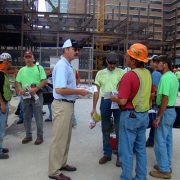Safety Tip of the Week: Preventing Falls
Almost any time you are working with access equipment, there is an inherent risk of falling. If you take the right precautions, though, you can increase safety in the workplace and prevent accidents from occurring. Here are a few safety tips for preventing falls on the job.
Use the Right Equipment
According to the Victorian WorkCover Authority, most falls that cause injury result from using unsafe scaffolds or inappropriate ladders. It is critical to always use the right access equipment for the job. It can be tempting to save time and money by hiring a scissor lift for every task on a worksite, but if the job demands the height and manoeuvrability of a boom lift, it is important to get one for your own safety, or the safety of your workers. Luckily we have plenty of boom lifts available for hire at Force to suit any job.
It is never OK to put a ladder on top of a lift to extend your reach another five meters. Force carries a huge range of lifts, and we are confident we can find the right access equipment to safely complete your job.
In addition to using access equipment that is the appropriate height and has the manoeuvrability needed, it’s also important to consider the conditions of the work. If you will be working on both slippery, outdoor terrain and flat, concrete services; make sure you get equipment that can safely transition between the two—or rent two pieces of equipment.
Keep a Tidy, Stocked Worksite
Preventing falls starts from the ground up. Make sure your worksite is safe by keeping walkways free of debris and spills. Ensure everyone on a worksite knows to stay out of harm’s way, and is careful to avoid knocking into equipment that could cause a fall. Always keep emergency equipment accessible, just in case.
Passive fall prevention tools, like railings, only work if installed properly. Other fall prevention equipment, for example, work positioning systems such as a rope access systems or travel restraint systems, are a good idea when working at height. In some cases, a safety net or harness system might also be appropriate. Check with your worksite health and safety expert to find out what, specifically, is required and what’s recommended.
Communicate Often
The National OHS contracted The Australian National University to analyse workplaces in order to pinpoint the factors contributing to falls and suggest guidelines on keeping worksites safe. They found that regular communication between employers and employees was crucial. A structured committee and regular meetings are one way to do this, but even informal conversations in the canteen are helpful.
Everyone on a worksite should constantly be identifying and discussing potential hazards. This will increase awareness and also provide opportunities to troubleshoot. Since most worksites include many different workers assigned to different responsibilities and tasks, it’s important to hear feedback on hazards and risks from everyone.
There’s enough stress in the workplace without a worry of falls. Follow these tips to increase safety and confidence on the job.



